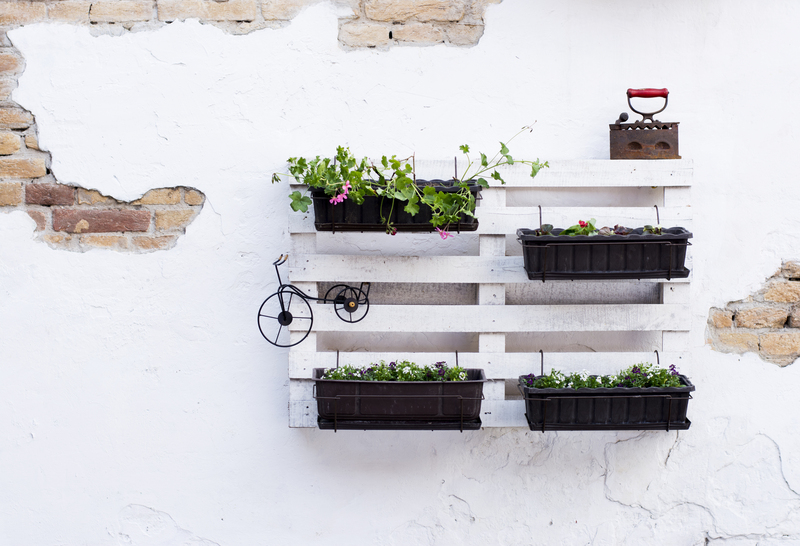Minimizing Environmental Impact of Pot Disposal
Pot disposal refers to the process of getting rid of pots used in gardening, cooking, or other applications. From plastic flowerpots to ceramic cookware, improper pot disposal can have significant consequences for our environment. In this comprehensive article, we explore eco-friendly methods and responsible practices for minimizing the environmental impact of pot disposal, ensuring both sustainability and compliance with best environmental standards.

Understanding the Environmental Effects of Improper Pot Disposal
Disposing of pots--whether plant containers, cooking pots, or industrial pottery--often involves sending these items to landfills or incineration facilities. Such practices can adversely affect the environment in various ways:
- Plastic pots may take hundreds of years to decompose, contributing to soil and water pollution as they break down into microplastics.
- Ceramic and clay pots are made from natural materials but often glazed with chemicals, posing risks if not processed correctly.
- Metal pots can rust and leach harmful substances into the soil or waterways, depending on their composition.
- Incinerating pots, especially those made from plastics, may release toxic emissions and greenhouse gases.
Given these challenges, adopting eco-friendly pot disposal methods is essential for environmental protection and sustainability efforts.
Types of Pots & Their Specific Environmental Impacts
Plastic Pots
Plastic pots are widely used owing to their affordability and low weight. However, their long degradation period and persistent chemicals make them a leading source of environmental pollution. These pots commonly end up as litter or in landfills, where they can take centuries to break down while leaching hazardous substances.
Ceramic & Clay Pots
Ceramic and clay pots decompose much more slowly than organics. While mostly inert, their paint and glaze coatings may contain lead, cadmium, or other heavy metals, which pose disposal challenges when broken or discarded improperly.
Metal Pots
From discarded cookware to old gardening tins, metal pots are often recyclable. However, if allowed to rust and degrade in uncontrolled environments, they add to soil and water contamination risks, especially if coated with nonstick surfaces or paint.
Biodegradable Pots and Planters
The emergence of biodegradable pots made from materials like coconut coir, peat, or compressed paper provides an eco-friendly alternative. These options minimize environmental impact by breaking down into harmless components in composting environments.
Strategies for Minimizing Environmental Impact of Pot Disposal
Mitigating the environmental consequences of pot disposal requires comprehensive strategies that emphasize reuse, recycling, and responsible discard practices. Below are the best approaches:
1. Reusing and Repurposing Pots
- Gardening: Clean, sanitize, and reuse old pots for new plants or seedlings.
- Home Decor: Repurpose broken or worn pots as decorative items for homes or gardens.
- DIY Projects: Use pots as storage containers, birdbaths, mosaic materials, or creative crafts.
Not only does creative reuse minimize pot waste, but it also encourages a circular economy where resources gain new life.
2. Recycling Pots Properly
Recycling remains one of the most effective ways to reduce the environmental burden of pot disposal. However, proper segregation is essential:
- Plastic Plant Pots: Check local recycling guidelines, as not all plastics are accepted. Rinse thoroughly and remove soil residues.
- Metal Pots: Most metal pots are recyclable at municipal drop-offs or scrap metal yards.
- Ceramic and Clay Pots: Some recycling centers accept broken ceramics for use as aggregate in construction materials or landscaping fill.
The key to diversion is cleaning pots of organic debris and ensuring they're sorted according to material type.
3. Composting Biodegradable Pots
Biodegradable plant pots made from peat, wood fiber, or cardboard can be composted at home or in commercial facilities. To compost:
- Break down the pots into smaller pieces for faster decomposition.
- Mix into compost piles with green and brown waste.
- Monitor moisture and aeration for optimal breakdown.
These pots turn into valuable humus, enriching soil rather than contributing to landfill mass.
4. Participating in Take-Back and Collection Programs
Many garden centers, nurseries, and cookware manufacturers now offer take-back or recycling programs. These initiatives make it easy for customers to return pots, ensuring they're managed responsibly via established recycling or reuse channels.
5. Donating Usable Pots
If your pots are still in good condition, consider donating them to:
- Community gardens
- Schools or educational programs
- Charity organizations
- Neighbors or local gardening clubs
This practice extends the usable life of pots, delaying disposal and supporting green community projects.
6. Disposing of Non-Recyclable Pots Responsibly
For pots contaminated with toxins, heavily damaged items, or non-recyclable plastics, ensure they're sent to appropriate waste management facilities. Never burn pots at home; always follow local hazardous waste disposal protocols, especially with pots containing glazes or paint with heavy metals.
Best Practices for Environmentally Friendly Pot Disposal
Cleaning and Preparing Pots for Disposal
Cleaning is key to maximizing recycling and reuse potential. Before dropping off or recycling, take these steps:
- Remove soils, roots, and plant debris from pots, as contamination can hinder recycling processes.
- Rinse thoroughly to remove chemical residues and fertilizers.
- Inspect for hazardous materials such as paint, glaze, or coatings, and seek specialized disposal options if needed.
Identifying the Right Disposal Channel
Navigating recycling rules can be challenging. Always:
- Check with local recycling centers and waste management authorities for accepted materials.
- Contact manufacturers or retailers about take-back programs.
- Read labels and symbols to determine recyclability, especially on plastic pots.
Switching to Eco-Friendly Pot Alternatives
To minimize future disposal issues, consider transitioning to more sustainable pot options:
- Biodegradable plant pots made from natural fibers.
- Unpainted and untreated clay pots for inert garden use.
- Recycled-content plastic or metal pots which can be recycled again at end of life.
- Locally-sourced containers to reduce transportation footprints.
Choosing eco-conscious designs at purchase helps minimize the environmental impact of pot disposal down the line.
Community Involvement and Education
Building awareness is essential. Share resources with neighbors, participate in local workshops, and encourage schools to educate students on sustainable pot disposal. Community action amplifies impact and fosters shared stewardship of local environments.
Regulatory and Industry Initiatives for Pot Recycling
Many regions are developing policies to promote sustainable pot disposal practices:
- Extended Producer Responsibility (EPR) Laws: Requiring manufacturers to manage end-of-life collection and processing of their products.
- Municipal Recycling Programs: Specifying acceptable pot materials and providing convenient drop-off points for recycling or composting.
- Industry Coalitions: Organizing standardized plastic pot recycling initiatives across retailers, botanical gardens, and garden supply stores.
How Retailers Are Helping "Close the Loop"
Some garden centers and big-box stores have implemented return bins for used pots. These collected items are sanitized, sorted, and either reused or sent to careful recyclers. This "closed-loop" philosophy helps keep materials in circulation, reducing extraction of new raw materials and energetic costs in production.
Case Studies: Successful Pot Disposal Programs
- Sustainable Gardening Programs: Nonprofits in North America and Europe have created community pot swap events, where used pots are exchanged and reused by gardeners. These efforts significantly reduce landfill contributions.
- Municipal Drop-Off Centers: Cities like Portland and Toronto offer dedicated drop-off sites for plant pots. Collected pots are professionally sorted and sent for recycling.
- Eco-Friendly Manufacturing: Several companies now use only recycled plastic for their plant pots, ensuring the entire lifecycle is eco-friendly and recyclable.
Common Mistakes to Avoid in Pot Disposal
- Throwing pots in general waste bins: This leads directly to landfill accumulation and missed recycling opportunities.
- Burning plastic and coated pots: Releases toxic fumes impacting both air quality and health.
- Discarding pots with soil and plant debris: Causes contamination and disrupts proper recycling processes.
- Ignoring local disposal codes: Failing to follow municipal guidelines may result in improper handling and fines.
- Failing to check for hazardous coatings: Can lead to environmental contamination--especially for old ceramic cookware or garden pots.

The Future of Environmentally Responsible Pot Disposal
As awareness and technology improve, the future of sustainable pot disposal is promising:
- New biodegradable materials and coatings, making pots safer and easier to compost.
- Wider adoption of take-back programs facilitated by major retailers.
- Greater emphasis on design for recyclability in the gardening and cookware industries.
- Enhanced community recycling infrastructure and educational campaigns.
By embedding sustainability into every stage--from design and manufacturing to disposal--we can collectively minimize the long-term environmental impacts of pot disposal.
Conclusion: Choosing Responsible Pot Disposal for a Greener Tomorrow
The environmental impact of pot disposal is a critical concern as we strive to build more sustainable communities and protect our ecosystems. With conscious effort, each of us can:
- Reuse and repurpose pots whenever possible.
- Recycle pots through proper, approved channels.
- Select biodegradable or eco-friendly pots to ease end-of-life processing.
- Participate in and support community, industry, and regulatory recycling initiatives.
- Educate friends, family, and neighbors about minimizing the environmental impact of pot disposal.
By making informed, environmentally friendly choices about pot disposal, we can help conserve resources, reduce waste, and pave the way for a sustainable future. Remember, every pot saved or recycled is a step toward a healthier planet.